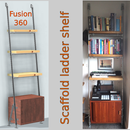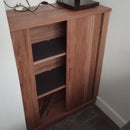Introduction: How to Make a Barrel Chair
I was looking to make some outdoor furniture and came across some chairs made from old oil barrels and immediately knew I was going to make some!!!
I looked on eBay to see if there were any barrels for sale close by and found a glass manufacture 5 miles away selling empty clean barrels for a bargain amount of £5 each, so I drove by and bought three. All I needed to do now was to work out how I was going to make the chairs.
Supplies
Empty barrel(s)
Plywood for the seat
Material for the seat (leather and foam)
Rubber edging
Metal brackets
Paint
Rivets and screws
Step 1: Planning
There are a few ways to cut the barrel depending on what end shape you want. I went for a design which would enable me to have a fairly high back and get two chairs out of one barrel.
I started off by taking the dimensions of the barrel and drawing the 'opened out' barrel in a CAD program. The main dimensions were determined by what looked good when I was sketching the cut lines out. The only thing you have to remember is when you add a line to, say to the top left, you have to add the same to the top right and the same each side of the centre-line at the bottom. After a little bit messing around I was happy with my final effort, so made sure that I had made a double symmetric shape by copying the top half, flipping it over and overlaying it on the other half.
I then transferred the dimensions to some paper to take to the work shop.
Attachments
Step 2: Sketching Out the Cut Lines
I started of the marking of the cut lines by cutting the radius of the curves on a bit of paper so I could draw them easily on the curved surface.
One I had determined the centre-line (according to the logo on the barrel) I started drawing the lines on the barrel with a pencil. On the curved sections I needed to go back over these lines once I had used my paper template.
Step 3: Cutting the Barrel
I used two tools to cut the barrel, an angle grinder with a thin cutting disc and a dremel with cut off discs. I also wore a full face mask as I didn't fancy any small shards of metal in my eyes.
I started off by re-marking the pencil lines with the dremel which mainly removed the paint so I could see the lines easier when using the angle grinder.
I then switched to the angle grinder and started off my cutting the horizontal and vertical lines - I generally took it quite easy, nice a slow stopping often to check my cuts. My plan was to use the dremel to cut the curved lines as they had a fairly tight radius, but having started this I decided to go back to the angle grinder.
To cut the radii I took light cuts around the curves increasing the cut depth little but little until I was nearly all the way through. I then switched to the dremel and finished them off with the small cut off discs.
Once cut I placed the two halves next to each other and they did look very similar. I then rubbed the edges down with some sandpaper to remove most of the sharpness!
Step 4: Make Chair Seat and Back Panel
I started by cutting a circular bit of 18mm plywood to the diameter I measured from the barrel and used my router table and straight bit to cut the circle. I followed this by cutting some foam that I had left over from an old mattress that I had kept for just this type of thing. It was quite thick so I sliced it in half on my bandsaw, which worked really well, so used the bandsaw to cut the foam to shape. I then added a curve to the edge to soften the feel of it.
I then took a large bit of leather (some recycled leather I've used over the years to line boxes) and stretched it across the back and stapled it in place, with A LOT of staples.
Step 5: Painting
I had in mind that I would keep the green to the outside so only needed to paint the inside. As there will be a 'shelf' underneath I thought this bit would look better quite dark inside so I only spray painted the top half in a vibrant yellow colour. I ended up doing four or five coats in the end.
Step 6: Seat Fixings
To fix the seat to the barrel I bought some cheap shelving bracket and used a riveter to fix them to the barrel.
This was the first time I've used a riveter and I like it very much! It's dead easy, just drill the holes in the right position, but the long part of the rivet in to the gun, put the end through the hole and keep squeezing the trigger until it pops shut, leaving the pin in the gun, and fixing the parts together.
I put four brackets in total which I think should do the job.
Step 7: Back Panel
At this point I decided to add a back panel to hopefully make it a little comfier. I made the panel from four bits of plywood, covered as per the seat and backed on to a flexible bit of hardboard. I wrapped the hardboard in a bit of old tent to keep it dry and fixed the panels to the back with screws.
I then fixed it to the barrel using four screws through the back.
Step 8: Edging
To cover the exposed edges I bought some car trim edging from Amazon. It was as simple as just pushing it on to the edges and cutting to size. I may end up adding some glue/adhesive to the edges if they keep getting pulled up but I have left as they are for the moment.
Step 9: Make Another One and Finishing Thoughts
Now the first half of the barrel was complete I made another one but this time in red with black leather (as I had run out of the other leather).
I also just picked up a free leather sofa I saw advertised which I spent a couple of hours with the kids dismantling it for the leather, foam and timber with hardly any waste. This material will come in very handy for such future projects.
I will also make a couple of covers for the chairs as I am keeping them outside.

Participated in the
Backyard Contest














